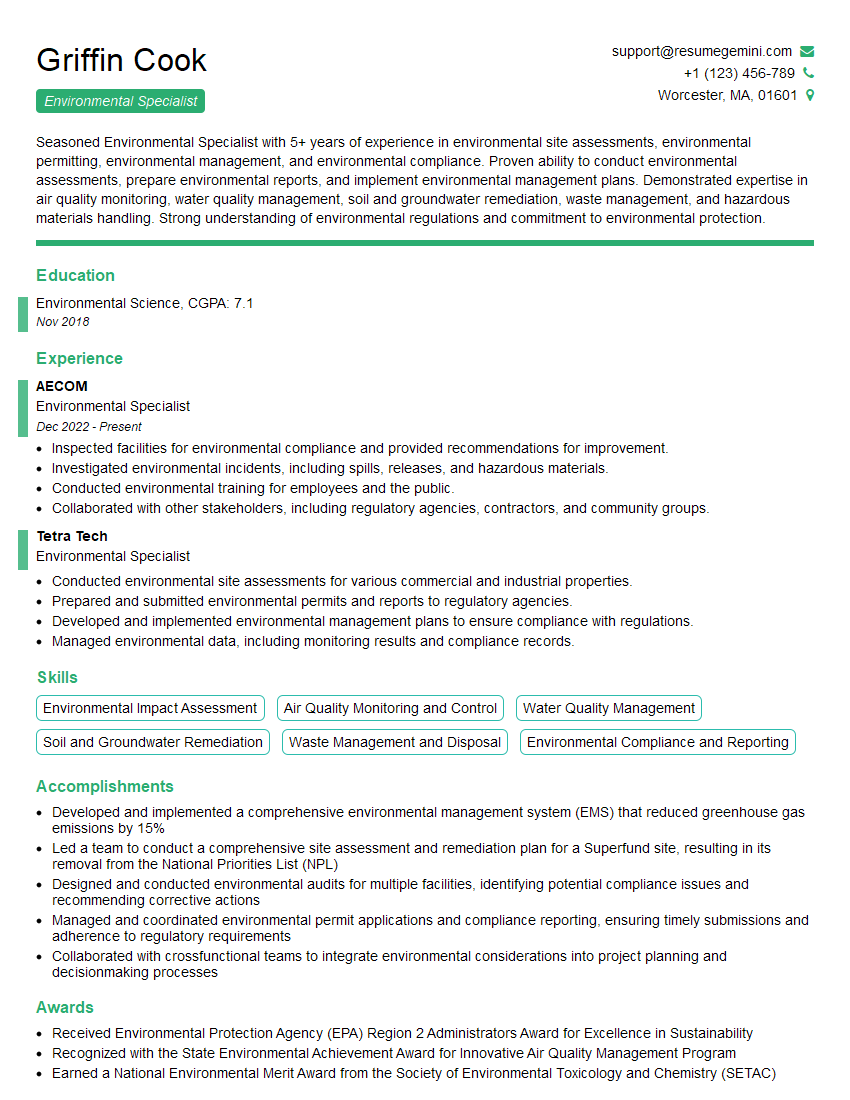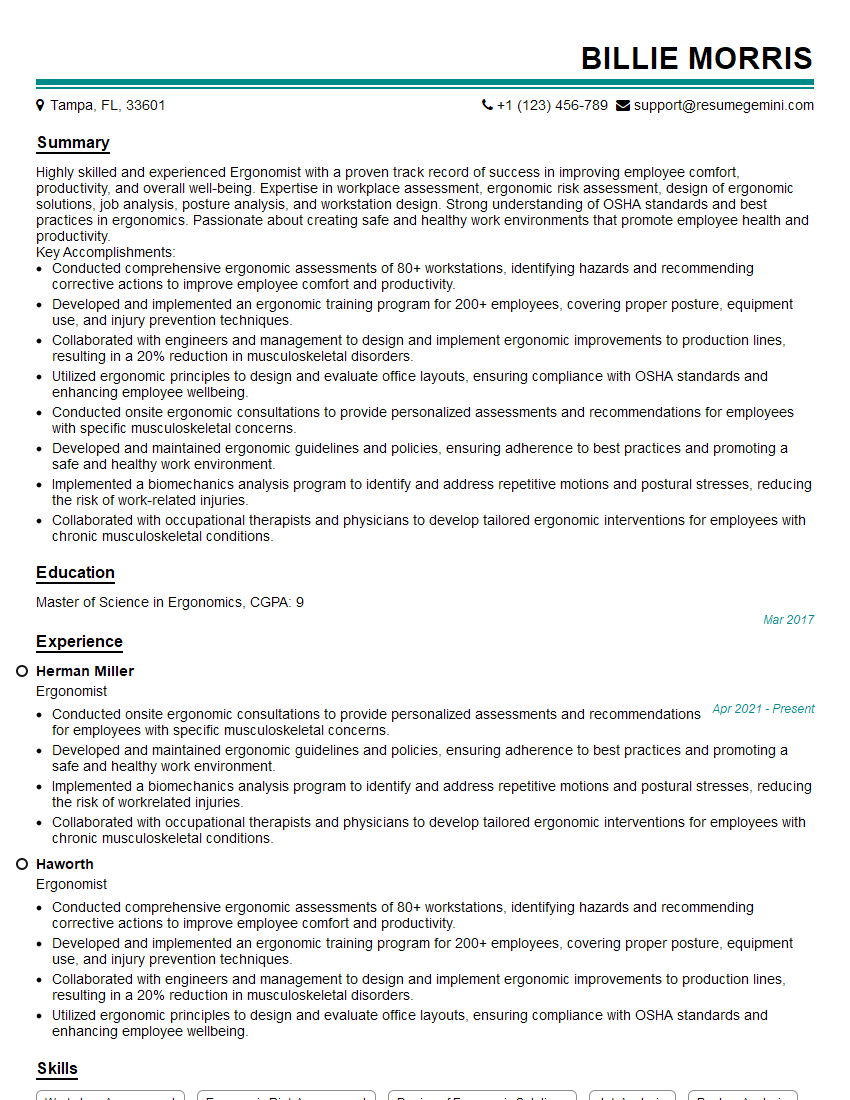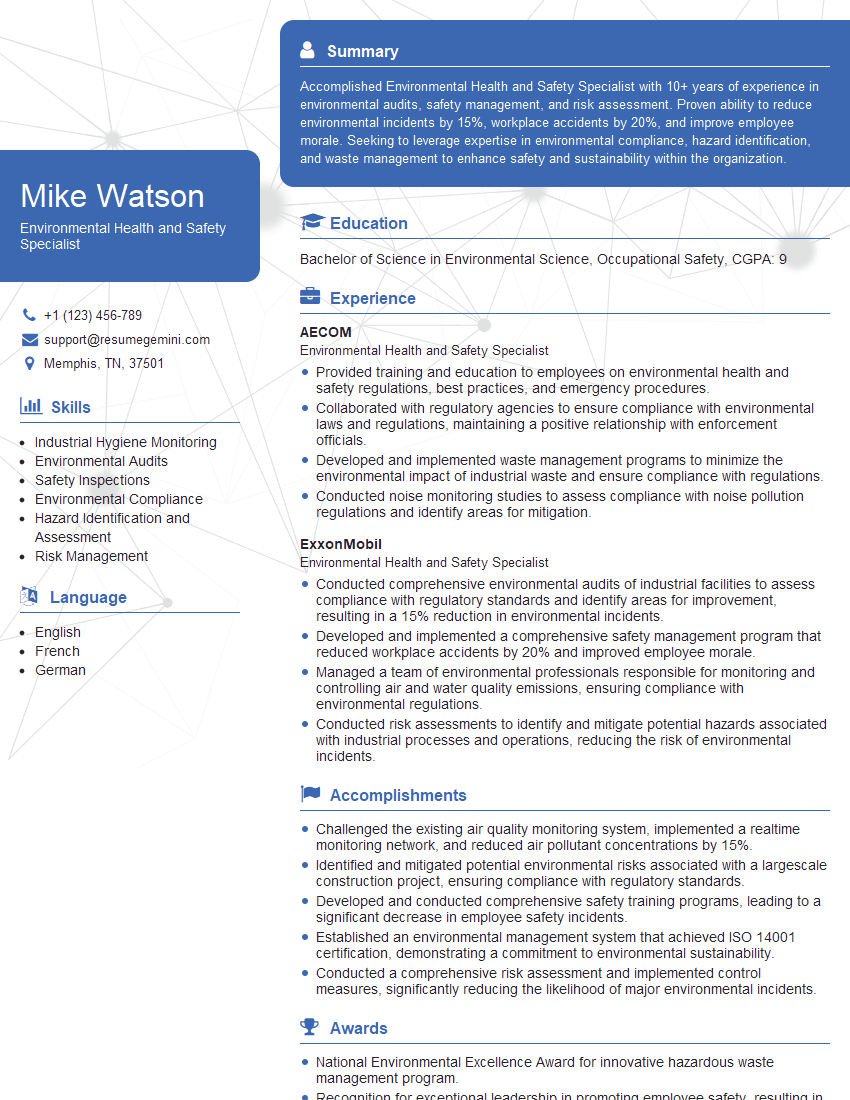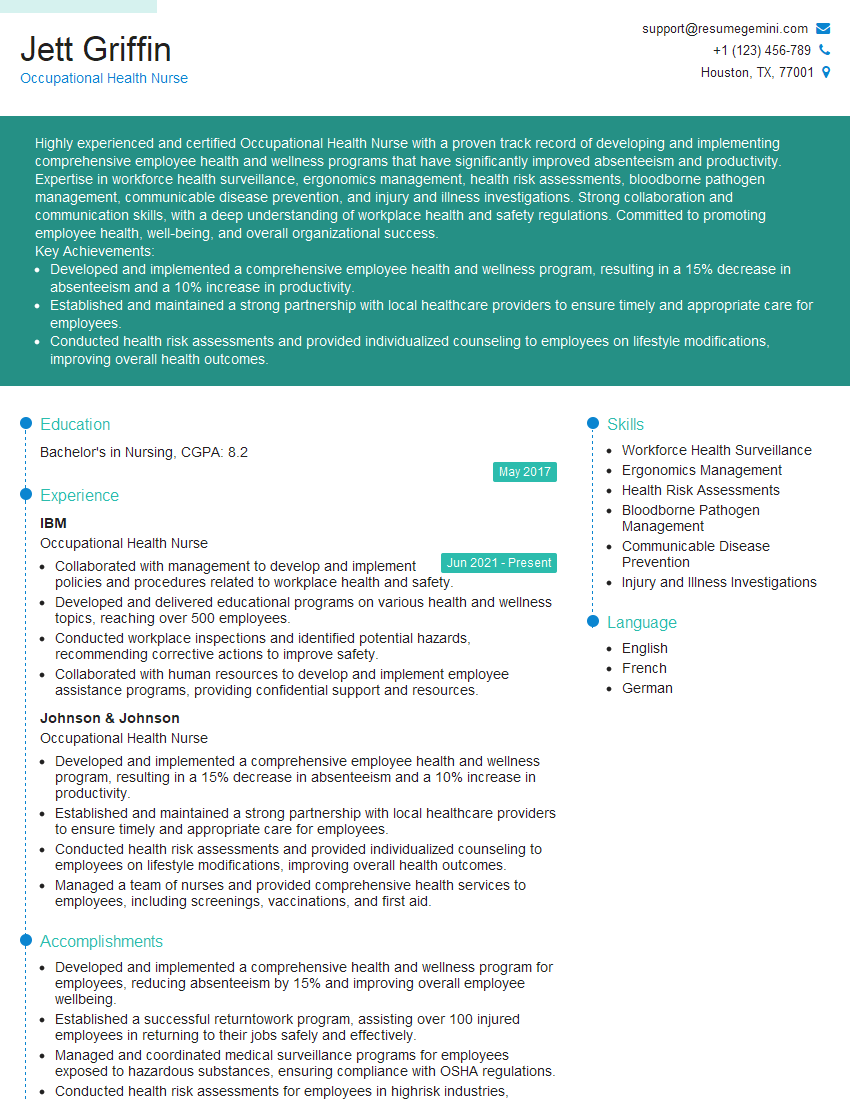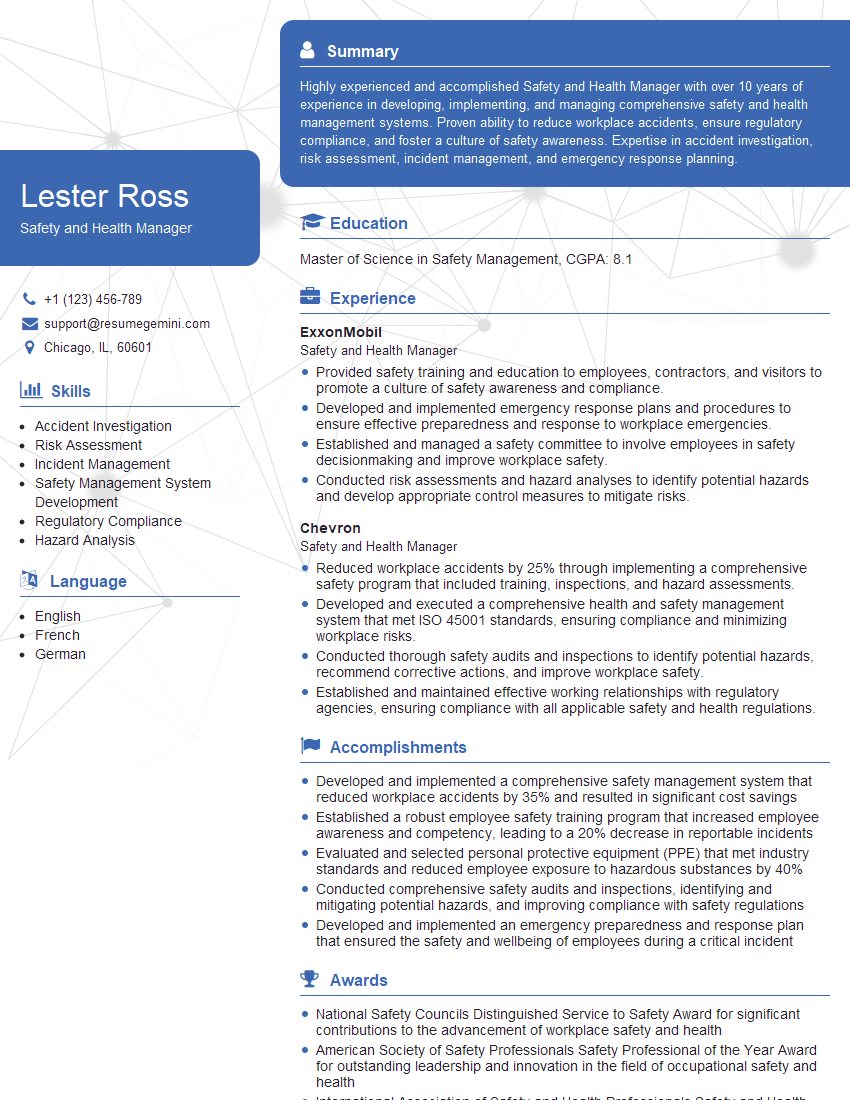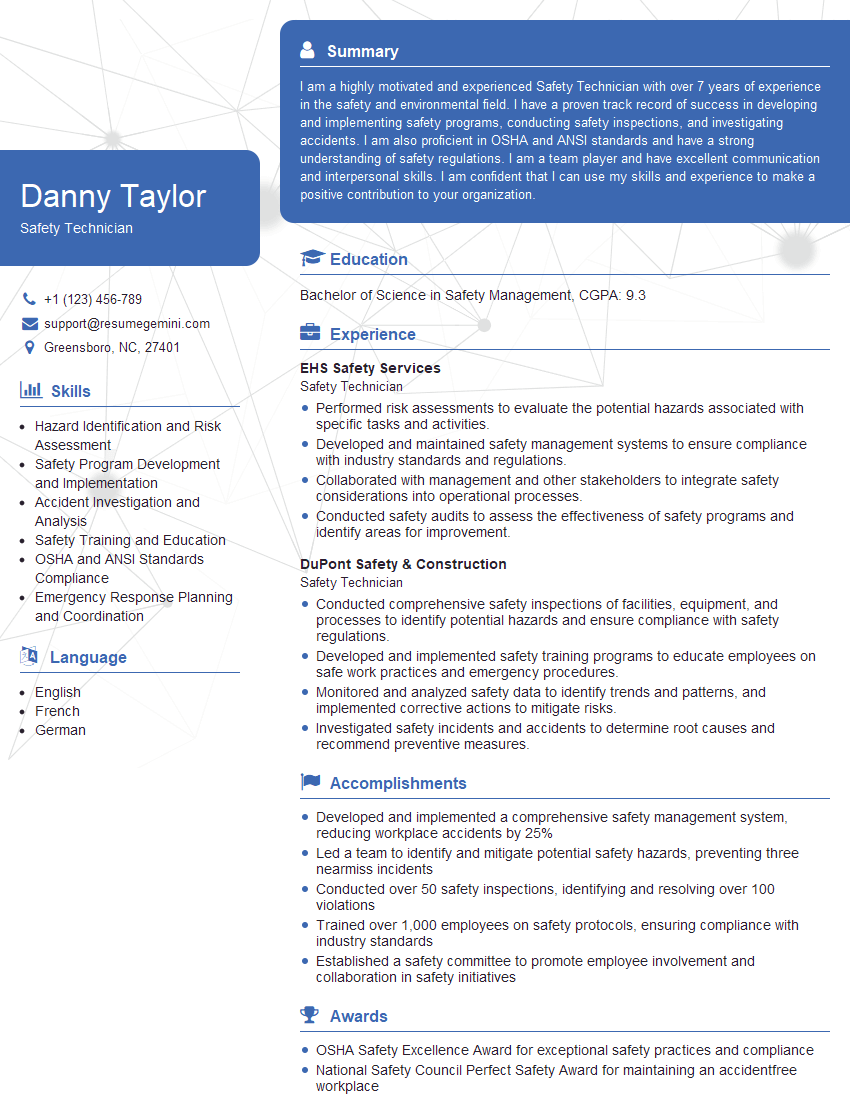Interviews are more than just a Q&A session—they’re a chance to prove your worth. This blog dives into essential ANSI Z400.1 interview questions and expert tips to help you align your answers with what hiring managers are looking for. Start preparing to shine!
Questions Asked in ANSI Z400.1 Interview
Q 1. Define ANSI Z400.1 and its scope.
ANSI Z400.1, “Safety and Health Program Management,” is a widely recognized American National Standard that provides a framework for establishing, implementing, and maintaining effective safety and health programs within organizations. Its scope encompasses all aspects of occupational safety and health management, promoting a proactive and comprehensive approach to risk control. This includes hazard identification, risk assessment, hazard control, training, and ongoing program evaluation. It’s not prescriptive, meaning it doesn’t dictate specific safety rules, but rather provides a structured roadmap for building a robust safety culture. It applies to virtually any workplace, regardless of industry or size, although certain aspects might be adapted based on specific hazards and working conditions.
Q 2. Explain the hierarchy of hazard controls according to ANSI Z400.1.
ANSI Z400.1 emphasizes a hierarchy of controls, prioritizing the most effective methods to eliminate or minimize hazards. This hierarchy, often visualized as a pyramid, prioritizes:
- Elimination: The most effective control is removing the hazard entirely. For example, replacing a hazardous chemical with a safer alternative. This is the preferred method.
- Substitution: Replacing a hazardous process, material, or piece of equipment with a less hazardous option. For example, using a robot to handle heavy objects instead of manual lifting.
- Engineering Controls: Implementing physical changes to the workplace to reduce exposure to hazards. Examples include installing machine guards, improving ventilation systems, or using isolation techniques.
- Administrative Controls: Implementing changes in workplace practices, policies, or procedures. Examples include implementing lockout/tagout procedures, job rotation, or providing more training.
- Personal Protective Equipment (PPE): Providing employees with PPE to mitigate risks when other control measures are insufficient or not feasible. This is the least effective method and should be considered a last resort. Examples include safety glasses, gloves, and respirators. Remember that PPE only protects the individual wearing it.
The standard strongly advocates for implementing controls higher in the hierarchy whenever possible.
Q 3. Describe the different types of hazards addressed by ANSI Z400.1.
ANSI Z400.1 addresses a broad range of hazards, encompassing:
- Physical Hazards: These include noise, vibration, heat stress, cold stress, radiation, and ergonomic hazards (repetitive motion injuries, awkward postures).
- Chemical Hazards: This covers exposure to toxic, corrosive, flammable, or explosive substances.
- Biological Hazards: This includes exposure to bacteria, viruses, fungi, and other biological agents.
- Ergonomic Hazards: These are hazards related to the physical demands of work and the interaction between workers and their tools, equipment, and workspace.
- Psychosocial Hazards: These encompass workplace stressors such as harassment, bullying, and excessive workloads.
- Safety Hazards: This covers hazards that can cause physical injury, such as falls, slips, trips, cuts, and machinery hazards.
The standard encourages a comprehensive approach, considering the interaction between various hazard types. For example, improper lifting techniques (ergonomic hazard) could lead to a back injury (safety hazard).
Q 4. What are the key elements of a successful safety program based on ANSI Z400.1?
A successful safety program based on ANSI Z400.1 features key elements, including:
- Management Commitment and Employee Involvement: Visible leadership support and active employee participation are crucial. This includes establishing safety committees and encouraging reporting of near misses and hazards.
- Hazard Identification and Risk Assessment: A systematic process for identifying potential hazards and assessing their associated risks. This involves considering the likelihood and severity of potential incidents.
- Hazard Control: Implementing the hierarchy of controls to effectively mitigate identified risks.
- Training and Education: Providing comprehensive safety training to all employees to ensure they understand hazards, risks, and appropriate control measures.
- Program Evaluation and Improvement: Regularly reviewing the safety program’s effectiveness, identifying areas for improvement, and making necessary adjustments.
- Record Keeping and Documentation: Maintaining accurate records of hazards, incidents, training, and program evaluations. This is vital for continuous improvement and demonstrating compliance.
- Communication and Emergency Preparedness: Establishing clear communication channels and developing effective emergency response plans.
The success of a program relies heavily on a strong safety culture where safety is prioritized at all levels.
Q 5. How does ANSI Z400.1 address risk assessment and management?
ANSI Z400.1 emphasizes proactive risk assessment and management. Risk assessment involves identifying hazards, analyzing their potential for causing harm (severity), and determining the likelihood of harm occurring (probability). The combination of severity and probability determines the level of risk. Management involves developing and implementing appropriate controls to mitigate identified risks. This process should be iterative, constantly evaluated and updated as needed. The standard doesn’t specify a single methodology for risk assessment but encourages a systematic approach. Methods like Job Hazard Analysis (JHA), Failure Mode and Effects Analysis (FMEA), or Fault Tree Analysis (FTA) could be used.
For example, consider a construction site. A risk assessment might identify the risk of falls from heights as high severity and high probability. Mitigation strategies might include implementing fall protection systems (engineering controls), implementing stricter procedures for working at heights (administrative controls), and requiring workers to wear harnesses and lanyards (PPE).
Q 6. Explain the concept of job hazard analysis (JHA) within the context of ANSI Z400.1.
A Job Hazard Analysis (JHA) is a systematic process for identifying hazards associated with a specific job task. Within the ANSI Z400.1 framework, JHAs are critical tools for proactive risk management. A JHA typically involves breaking down a job into its individual steps, identifying potential hazards associated with each step, and determining appropriate control measures. The outcome is a documented record of the hazards, risks, and control measures for that specific job, aiding in training and ongoing risk assessment. JHAs are particularly useful for high-risk tasks and for identifying hazards that might not be immediately obvious.
For instance, a JHA for changing a lightbulb might identify the hazard of falling from a ladder. Control measures would then be documented, such as using a stable ladder, securing the ladder properly, and ensuring adequate lighting.
Q 7. How does ANSI Z400.1 incorporate the principles of ergonomics?
ANSI Z400.1 indirectly addresses ergonomics by emphasizing the need to control hazards related to the physical demands of work. The standard promotes a holistic approach to workplace safety, recognizing that musculoskeletal disorders and other ergonomic-related injuries are significant occupational hazards. By focusing on hazard identification and control, the standard inherently encourages the implementation of ergonomic principles. This includes designing workspaces, tools, and tasks to minimize physical strain, promote proper posture, and reduce repetitive movements. The implementation of ergonomic controls is part of the hierarchy of controls detailed in the standard.
Examples of incorporating ergonomics include using adjustable workstations, providing proper lifting techniques training, and employing tools that reduce strain on muscles and joints.
Q 8. What are the requirements for personal protective equipment (PPE) as outlined in ANSI Z400.1?
ANSI Z400.1, American National Standard for Occupational and Educational Eye and Face Protection, doesn’t directly dictate *specific* PPE requirements but establishes criteria for selecting, using, and maintaining appropriate eye and face protection. It focuses on hazard assessment as the cornerstone. The standard emphasizes that the selection of PPE must be appropriate for the specific hazard encountered. For instance, a welder needs a different type of eye protection than someone working with a grinder.
The process involves:
- Hazard Assessment: Identifying potential eye and face hazards (e.g., impact, chemical splashes, radiation). This is the crucial first step. Without a proper assessment, selecting the wrong PPE is common and dangerous.
- PPE Selection: Choosing the right type of eye and face protection based on the identified hazards (e.g., safety glasses, goggles, face shields, welding helmets). ANSI Z87.1 provides specific standards for the performance requirements of the PPE itself.
- Use and Maintenance: Ensuring the PPE is used correctly and maintained regularly to ensure continued effectiveness. A scratched face shield is far less effective.
- Training: Providing employees with training on proper selection, use, and care of PPE.
Think of it like this: Z400.1 is the overarching framework, while Z87.1 provides the detailed specifications for the equipment itself. They work together to ensure effective eye and face protection.
Q 9. Describe the importance of safety training in accordance with ANSI Z400.1.
Safety training is paramount according to ANSI Z400.1. It’s not just about checking a box; effective training is a cornerstone of a successful safety program. The standard indirectly mandates training by emphasizing that workers need to understand the hazards they face and how to protect themselves. Without proper training, even the best PPE is useless.
Effective safety training should cover:
- Hazard Identification: Teaching workers to recognize potential eye and face hazards in their work environment.
- PPE Selection and Use: Training on the proper selection, fit, and use of various types of eye and face protection.
- Maintenance and Inspection: Educating workers on how to inspect and maintain their PPE to ensure its effectiveness.
- Emergency Procedures: Training on what to do in case of an eye or face injury.
Imagine a construction worker who doesn’t understand the importance of wearing safety glasses while using a power tool. A simple piece of debris could cause a serious eye injury. Proper training directly reduces this risk. Regular refresher training is equally vital to maintain competency.
Q 10. How does ANSI Z400.1 address incident investigation and reporting?
ANSI Z400.1 doesn’t prescribe a specific incident investigation and reporting system, but the underlying principle of continuous improvement necessitates thorough investigation and corrective actions following any eye or face injury. The goal is to prevent recurrence.
A robust incident investigation should include:
- Immediate Actions: First aid, medical attention, and securing the scene.
- Data Collection: Gathering information about the incident, including the type of hazard, the PPE used (or not used), and witness statements.
- Root Cause Analysis: Determining the underlying causes of the incident to prevent future occurrences (e.g., inadequate training, faulty equipment, unsafe procedures).
- Corrective Actions: Implementing measures to correct the identified hazards and prevent similar incidents from happening again (e.g., new safety procedures, improved training, equipment replacement).
- Documentation: Maintaining thorough records of the incident, investigation, and corrective actions.
For example, if a worker suffered an eye injury due to a flying particle, the investigation would determine if the worker was wearing appropriate safety glasses, if the glasses were properly maintained, and if the machinery involved was operating safely. The corrective actions might include additional training, improved machine guarding, or better enforcement of safety rules.
Q 11. Explain the role of safety committees and their alignment with ANSI Z400.1.
ANSI Z400.1 doesn’t explicitly mandate safety committees, but the principles of worker participation and proactive hazard control strongly suggest their value. A well-functioning safety committee can significantly enhance the effectiveness of a safety program.
A safety committee aligned with ANSI Z400.1 principles would:
- Participate in Hazard Assessments: Identify potential eye and face hazards in the workplace.
- Review Incident Reports: Analyze incidents and recommend corrective actions.
- Develop and Implement Safety Programs: Help create and implement programs to improve eye and face protection.
- Provide Training: Assist in the development and delivery of safety training.
- Monitor PPE Use: Ensure that workers are using appropriate PPE correctly.
The committee acts as a crucial link between management and employees, fostering a culture of safety and providing a platform for employees to voice concerns and contribute to improving safety practices. A diverse committee, representing all levels of the workforce, ensures a holistic approach to hazard identification and control.
Q 12. What are some common misconceptions about ANSI Z400.1?
Some common misconceptions about ANSI Z400.1 include:
- It mandates specific PPE: Z400.1 is a guideline, not a prescription. It doesn’t state “wear X type of goggles”. Instead, it emphasizes a risk assessment-driven approach to PPE selection.
- It’s only about eye protection: While primarily focused on eye and face protection, the underlying principles of hazard assessment and control apply to other safety areas.
- It’s a standalone standard: Z400.1 works in conjunction with other standards, such as ANSI Z87.1 (for personal eye and face protection devices).
- Compliance is optional: While not directly enforceable by itself, it informs best practices and contributes to compliance with OSHA regulations (more on that below).
Understanding these misconceptions is crucial for correctly implementing the principles of ANSI Z400.1.
Q 13. How does ANSI Z400.1 relate to OSHA regulations?
ANSI Z400.1 and OSHA regulations are closely related but distinct. OSHA (Occupational Safety and Health Administration) sets legally enforceable safety and health standards, while ANSI Z400.1 provides a consensus-based standard for best practices. OSHA often references ANSI standards, including Z400.1, as a guide for compliance.
In essence:
- OSHA sets the legal requirements. These are minimum standards that employers must meet.
- ANSI Z400.1 provides best practices. Following its guidelines can help demonstrate compliance with OSHA and contribute to a safer work environment that surpasses minimum requirements.
OSHA’s General Duty Clause, which requires employers to provide a workplace free from recognized hazards, often intersects with the principles outlined in ANSI Z400.1. Using ANSI Z400.1 as a framework demonstrates a proactive approach to hazard control and reduces the risk of OSHA citations.
Q 14. Describe the process of developing and implementing a safety plan based on ANSI Z400.1.
Developing and implementing a safety plan based on ANSI Z400.1 is an iterative process. It requires commitment from all levels of the organization. Here’s a step-by-step approach:
- Conduct a thorough hazard assessment: Identify all potential eye and face hazards in the workplace, considering factors like the type of work, the materials used, and the equipment involved. This might involve walkthroughs, job hazard analyses, and input from employees.
- Select appropriate PPE: Based on the hazard assessment, choose the appropriate type of eye and face protection that meets or exceeds the requirements of ANSI Z87.1. Consider factors such as comfort, fit, and compatibility with other PPE.
- Develop a training program: Create a comprehensive training program that covers hazard recognition, PPE selection, proper use and maintenance, and emergency procedures. Training should be tailored to the specific hazards identified in the assessment.
- Establish procedures for PPE use, maintenance, and storage: Develop clear procedures for how PPE should be used, inspected, cleaned, stored, and replaced. These procedures should be documented and easily accessible to all workers.
- Implement a system for monitoring and evaluating PPE effectiveness: Regularly monitor the effectiveness of the PPE program through inspections, audits, and feedback from workers. Adjust the program as needed to ensure it remains effective in mitigating identified hazards.
- Establish an incident investigation and reporting process: Create a system for investigating and reporting eye and face injuries, including root cause analysis and corrective actions. This helps identify areas for improvement and prevent future incidents.
- Document everything: Maintain detailed records of the hazard assessment, PPE selection, training program, procedures, monitoring results, and incident investigations. This documentation provides evidence of compliance and aids in continuous improvement.
Remember that this is a continuous process; regularly review and update the safety plan based on new information, changes in the workplace, and feedback from workers. The goal is to create a proactive and dynamic safety program to protect workers’ eyes and faces.
Q 15. How do you measure the effectiveness of a safety program aligned with ANSI Z400.1?
Measuring the effectiveness of a safety program aligned with ANSI Z400.1 isn’t a one-size-fits-all process. It requires a multifaceted approach that considers leading and lagging indicators. Leading indicators predict future performance, while lagging indicators reflect past performance. We need both to get a complete picture.
Leading Indicators: These focus on proactive measures. Examples include the number of safety training hours completed, the frequency of safety inspections conducted, the number of near misses reported, and employee participation in safety committees. A high number of training hours suggests a proactive safety culture, while a high number of near misses, *if properly investigated and addressed*, indicates a system that encourages reporting and allows for preventative measures.
Lagging Indicators: These reflect the outcomes of the safety program. Examples include the total recordable incident rate (TRIR), the lost time injury rate (LTIR), and the number of OSHA citations. A decrease in these lagging indicators demonstrates the effectiveness of the safety program in reducing workplace accidents and injuries. It’s crucial to analyze trends over time, not just snapshot data.
Effective Measurement: We’d establish baselines for key indicators, track progress regularly, and compare results against industry benchmarks. Regular reviews and adjustments to the safety program are essential based on data analysis. Think of it like a doctor monitoring a patient’s health – regular check-ups are critical to maintain wellbeing.
Career Expert Tips:
- Ace those interviews! Prepare effectively by reviewing the Top 50 Most Common Interview Questions on ResumeGemini.
- Navigate your job search with confidence! Explore a wide range of Career Tips on ResumeGemini. Learn about common challenges and recommendations to overcome them.
- Craft the perfect resume! Master the Art of Resume Writing with ResumeGemini’s guide. Showcase your unique qualifications and achievements effectively.
- Don’t miss out on holiday savings! Build your dream resume with ResumeGemini’s ATS optimized templates.
Q 16. What are the key performance indicators (KPIs) used to assess safety performance based on ANSI Z400.1?
Key Performance Indicators (KPIs) for assessing safety performance based on ANSI Z400.1 principles should encompass both leading and lagging indicators. They should be measurable, achievable, relevant, and time-bound (SMART).
- Lagging Indicators:
- Total Recordable Incident Rate (TRIR): The number of recordable cases per 200,000 hours worked.
- Lost Time Injury Rate (LTIR): The number of lost-time injuries per 200,000 hours worked.
- Days Away, Restricted, or Transferred (DART) Rate: The number of days employees are away from work due to injury.
- Severity Rate: A measure of the severity of injuries, often expressed in days lost per 1,000 hours worked.
- Leading Indicators:
- Number of safety training hours per employee.
- Number of safety inspections conducted.
- Number of near misses reported.
- Employee participation in safety committees or initiatives.
- Safety observation scores.
- Number of corrective actions implemented.
It’s vital to track these KPIs regularly, analyze trends, and use the data to make informed decisions to improve the safety program. Using data visualization tools can make it easier to identify patterns and trends.
Q 17. Explain the importance of safety audits in relation to ANSI Z400.1.
Safety audits, as per ANSI Z400.1 principles, are crucial for evaluating the effectiveness of a safety management system (SMS). They provide an independent assessment of the controls in place, identifying gaps and areas for improvement. Think of a safety audit as a comprehensive health check for your safety program.
Importance:
- Identifying Hazards and Risks: Audits uncover existing and potential hazards that might otherwise be missed during routine operations.
- Evaluating Effectiveness of Controls: They assess the effectiveness of implemented safety controls, ensuring they are functioning as intended and are sufficient to mitigate identified risks.
- Compliance Verification: Audits verify compliance with relevant safety regulations, standards, and internal policies.
- Improving Safety Performance: By pinpointing weaknesses, audits inform the development of corrective actions and improvements to the SMS, leading to a safer work environment.
- Demonstrating Commitment: Conducting regular safety audits shows a strong commitment to worker safety and responsible business practices, potentially reducing insurance premiums.
A well-structured safety audit program should incorporate a combination of planned, unannounced, and follow-up audits to ensure a comprehensive evaluation of the SMS. The audit findings should be documented, and corrective actions should be implemented and tracked.
Q 18. How do you handle conflicts between ANSI Z400.1 and other relevant standards?
Conflicts between ANSI Z400.1 and other relevant standards require careful consideration and a hierarchical approach. The most stringent standard should always prevail. This means selecting the standard offering the highest level of protection for workers.
Resolution Steps:
- Identify the Conflict: Clearly define the specific clauses or requirements in conflict between ANSI Z400.1 and other standards (e.g., OSHA regulations, industry-specific standards).
- Determine the Applicability: Analyze the applicability of each standard to the specific situation. Consider the jurisdiction and specific workplace hazards.
- Prioritize the Standard: Determine which standard provides the more stringent or comprehensive requirements. If there’s ambiguity, seek clarification from regulatory authorities or subject-matter experts.
- Implement the More Stringent Standard: Implement the standard that offers the greatest level of protection. Document the decision-making process to ensure transparency and traceability.
- Continuously Monitor and Review: Regularly review and update safety procedures to ensure ongoing compliance with the selected standard and address any changes in regulations or best practices.
For example, if OSHA regulations require more frequent safety inspections than suggested by ANSI Z400.1, then OSHA’s requirement should be followed.
Q 19. Describe your experience with conducting safety inspections and writing reports.
I have extensive experience conducting safety inspections and writing comprehensive reports. My approach is systematic and data-driven, aiming to identify hazards and potential risks, not just documenting existing conditions.
Inspection Process:
- Planning: Defining the scope of the inspection, identifying specific areas to focus on based on risk assessments and previous incidents.
- Inspection: Using checklists and observation techniques to thoroughly evaluate the workplace, paying attention to details, following established protocols.
- Documentation: Recording observations meticulously, including photographs and detailed descriptions of hazards, non-compliances, and good practices. Maintaining a chain of custody for evidence.
- Report Writing: Preparing a clear, concise, and comprehensive report that includes findings, observations, conclusions, and recommendations for corrective actions. Prioritizing critical hazards.
- Follow-up: Verifying the implementation of corrective actions and conducting follow-up inspections to ensure their effectiveness.
In my reports, I prioritize clarity and use plain language, avoiding technical jargon whenever possible. I always include photographic evidence and specific location details to ensure easy identification of hazards.
Q 20. Explain your approach to investigating and analyzing workplace accidents.
Investigating workplace accidents requires a methodical approach focused on identifying root causes, not just assigning blame. My approach aligns with ANSI Z400.1’s emphasis on proactive hazard control and continuous improvement.
Investigation Process:
- Secure the Scene: Ensure the safety of personnel and preserve evidence. Take photographs and document the scene before moving anything.
- Gather Information: Interview witnesses, review records, examine equipment, and analyze data. Collect information from multiple sources.
- Analyze Data: Identify contributing factors, root causes, and systemic issues that led to the accident. Use techniques like fault tree analysis or fishbone diagrams.
- Develop Corrective Actions: Formulate specific, measurable, achievable, relevant, and time-bound (SMART) corrective actions to prevent similar incidents in the future. Address root causes, not just symptoms.
- Report and Follow-up: Prepare a comprehensive report detailing the findings, root causes, corrective actions, and recommendations. Monitor the effectiveness of the corrective actions and implement further improvements as needed.
This systematic approach ensures that accidents are not merely investigated but used as learning opportunities to improve safety practices and prevent future incidents.
Q 21. How do you communicate safety information effectively to employees?
Effective communication of safety information to employees is critical for a successful safety program. My approach involves using a multi-faceted strategy that caters to different learning styles and communication preferences.
Communication Strategies:
- Regular Safety Meetings: Conducting regular meetings to discuss safety topics, share information, and address employee concerns.
- Safety Training: Providing comprehensive safety training tailored to specific job roles and hazards, using a variety of methods including classroom instruction, online modules, and hands-on training.
- Visual Communication: Using posters, signs, and videos to convey safety messages in a clear and engaging manner. Visuals are effective in conveying complex information.
- Written Communication: Distributing safety manuals, newsletters, and other written materials to ensure consistent access to information.
- Interactive Tools: Utilizing interactive tools, such as quizzes and simulations, to engage employees and reinforce learning.
- Feedback Mechanisms: Establishing open channels of communication, such as suggestion boxes and anonymous reporting systems, to encourage employee feedback and identify potential hazards.
- Leading by Example: Management actively demonstrating commitment to safety by following all safety rules and procedures. This sends a strong message of importance.
Effective communication requires adapting to the audience. Regular feedback and evaluation of the communication methods employed is essential to ensure ongoing effectiveness.
Q 22. How familiar are you with the different types of hazard communication methods?
ANSI Z400.1, the American National Standard for Occupational and Environmental Safety and Health, outlines various hazard communication methods. These methods aren’t mutually exclusive; a comprehensive safety program utilizes several approaches to ensure effective communication.
Labels and Marking: This is the primary method. Labels on containers, equipment, and storage areas clearly identify hazards using pictograms, signal words (Danger, Warning), hazard statements, and precautionary statements. For example, a container of corrosive acid would prominently display a corrosive pictogram, the signal word ‘Danger,’ and specific hazard and precautionary statements.
Safety Data Sheets (SDSs): SDSs provide detailed information about the hazards of chemicals and other substances. They’re comprehensive documents outlining physical and chemical properties, health hazards, first aid measures, fire-fighting measures, accidental release measures, handling and storage, exposure controls/personal protection, physical and chemical properties, stability and reactivity, toxicological information, ecological information, disposal considerations, transport information, regulatory information, and other relevant information. A properly formatted SDS is crucial for emergency response and informed decision-making.
Training Programs: Effective training is paramount. Workers need to understand the hazards they face, how to handle hazardous materials, and what to do in case of an emergency. Training must be tailored to the specific hazards in the workplace and should include hands-on demonstrations and practical exercises.
Written Hazard Communication Programs: Many workplaces require a written program that outlines their hazard communication process, including how they select, implement, and maintain their hazard communication system.
Other Methods: These could include safety meetings, posters, emergency response plans, and toolbox talks. These methods supplement labels, SDSs, and training to reinforce hazard awareness.
Q 23. Describe your experience with developing and delivering safety training programs.
I have extensive experience designing and delivering safety training programs, focusing on practical application and engagement. My approach incorporates various methods such as interactive lectures, case studies, simulations, and hands-on activities to cater to diverse learning styles. For example, I developed a comprehensive training program for a manufacturing plant focusing on lockout/tagout procedures. This program involved classroom instruction, simulated equipment lockouts, and practical assessments to ensure employee competency. Feedback mechanisms were incorporated, and the program was regularly updated based on incident reports and regulatory changes. I’ve also delivered training on hazard communication, personal protective equipment (PPE) selection and use, and emergency response procedures, always tailoring content to the specific workplace environment and employee needs.
Q 24. What are some best practices for promoting a positive safety culture in the workplace?
A positive safety culture is built on several key pillars. It’s not just about following rules; it’s about fostering a shared sense of responsibility for safety.
Leadership Commitment: Visible and active commitment from leadership is crucial. Leaders must model safe behavior, actively participate in safety initiatives, and ensure sufficient resources are allocated to safety programs.
Employee Involvement: Workers should be actively involved in identifying hazards, developing solutions, and participating in safety committees. This empowers employees and creates ownership of safety.
Open Communication: Creating a culture where employees feel comfortable reporting near misses, accidents, and safety concerns without fear of retribution is vital. This allows for proactive identification and mitigation of hazards.
Effective Training: Regular and comprehensive safety training tailored to job roles and hazards ensures employees are equipped to work safely.
Consistent Enforcement: Fair and consistent enforcement of safety rules and regulations sends a clear message that safety is a priority. This doesn’t mean punishing employees but reinforcing safe practices.
Recognition and Rewards: Recognizing and rewarding employees who demonstrate safe work habits reinforces positive behavior and encourages others to follow suit.
Q 25. How do you stay current with changes and updates to ANSI Z400.1?
Staying current with ANSI Z400.1 and other related safety standards requires a multi-pronged approach.
Subscription to Standards Organizations: Maintaining a membership with organizations like ANSI allows for access to the latest updates and revisions.
Professional Development: Attending conferences, workshops, and training sessions focused on occupational safety and health keeps me abreast of the latest industry best practices and emerging safety challenges.
Networking: Engaging with other safety professionals through professional associations and online forums facilitates the exchange of information and insights.
Regular Review of Regulatory Updates: Monitoring government websites and publications related to OSHA (Occupational Safety and Health Administration) regulations and guidelines is crucial, as many standards are intertwined.
Q 26. How would you address a situation where an employee refuses to follow safety procedures?
Addressing an employee’s refusal to follow safety procedures requires a careful and progressive approach.
Understanding the Reason: First, I’d attempt to understand the reason behind the refusal. Are they unclear about the procedure? Do they feel the procedure is impractical or cumbersome? Do they have concerns about their safety?
Re-education and Clarification: If the issue stems from a lack of understanding, I’d provide additional training and clarification, perhaps with hands-on demonstration.
Addressing Concerns: If the employee has valid concerns, I’d work with them to find a solution that addresses those concerns while maintaining safety standards. This might involve modifying the procedure or providing additional equipment.
Disciplinary Action: If the refusal persists despite attempts at education and collaboration, disciplinary action, as outlined in the company’s policies, might be necessary. This could range from verbal warnings to suspension, depending on the severity of the infraction and company policy. Documentation of each step is crucial.
Q 27. Describe a time you had to make a difficult decision regarding workplace safety.
In a previous role, I faced a situation where a piece of equipment was malfunctioning, posing a potential safety hazard. While the repair would involve some downtime, ignoring the issue posed a greater risk. The decision to shut down the equipment, incurring production losses, was difficult given tight deadlines. However, prioritizing the safety of the employees was paramount. I documented the issue, involved maintenance personnel immediately, and communicated the shutdown to upper management, explaining the rationale and potential consequences of continuing operation. The immediate shutdown prevented a potential accident, even though it came with short-term production setbacks. The incident highlighted the importance of proactive hazard identification and the necessity of prioritizing safety over short-term production gains.
Q 28. Explain your understanding of the legal and ethical responsibilities related to workplace safety.
Workplace safety is governed by a complex interplay of legal and ethical responsibilities. Legally, employers have a duty of care to provide a safe working environment for their employees, complying with all applicable laws and regulations such as OSHA standards. Failure to do so can result in significant penalties, including fines and even criminal charges. Ethically, an employer has a moral obligation to protect the well-being of their employees. This extends beyond simply complying with the law to fostering a culture of care and respect. It means actively seeking to identify and eliminate hazards, providing appropriate training and equipment, and ensuring employees are empowered to report safety concerns without fear of reprisal. Employees, too, have ethical responsibilities to adhere to safety procedures and report unsafe conditions, acting responsibly to protect themselves and their colleagues. Ignoring safety procedures is not only legally problematic but also ethically irresponsible. Transparency, accountability, and a commitment to safety are the cornerstones of both legal compliance and ethical conduct in the workplace.
Key Topics to Learn for ANSI Z400.1 Interview
Mastering ANSI Z400.1 opens doors to exciting opportunities. To excel in your interview, focus on these key areas:
- Understanding the Scope and Purpose: Grasp the fundamental objectives of ANSI Z400.1 and its role in safety and hazard control.
- Hazard Identification and Risk Assessment: Practice identifying potential hazards and applying various risk assessment methodologies as outlined in the standard. Consider real-world scenarios to solidify your understanding.
- Control Hierarchy and Implementation: Become proficient in applying the control hierarchy (elimination, substitution, engineering controls, administrative controls, PPE) and explain how to choose the most effective control measures.
- Safety Program Development and Management: Understand the principles of creating and managing a comprehensive safety program that aligns with ANSI Z400.1 guidelines.
- Documentation and Record Keeping: Familiarize yourself with the necessary documentation procedures and record-keeping requirements for compliance.
- Performance Measurement and Continuous Improvement: Learn how to track safety performance, identify areas for improvement, and implement corrective actions.
- Relevant Regulations and Compliance: Understand how ANSI Z400.1 interacts with other relevant safety regulations and standards within your industry.
Next Steps
Proficiency in ANSI Z400.1 significantly enhances your career prospects in safety and health-related fields. A strong understanding of this standard demonstrates a commitment to safety and showcases your valuable expertise to potential employers. To maximize your chances of landing your dream role, it’s crucial to present your skills effectively. Creating an ATS-friendly resume is key to getting your application noticed. ResumeGemini is a trusted resource that can help you craft a compelling and effective resume that highlights your ANSI Z400.1 knowledge. Examples of resumes tailored to ANSI Z400.1 expertise are available through ResumeGemini to help you get started. Take the next step towards your successful career today!
Explore more articles
Users Rating of Our Blogs
Share Your Experience
We value your feedback! Please rate our content and share your thoughts (optional).
What Readers Say About Our Blog
Take a look at this stunning 2-bedroom apartment perfectly situated NYC’s coveted Hudson Yards!
https://bit.ly/Lovely2BedsApartmentHudsonYards
Live Rent Free!
https://bit.ly/LiveRentFREE
Interesting Article, I liked the depth of knowledge you’ve shared.
Helpful, thanks for sharing.
Hi, I represent a social media marketing agency and liked your blog
Hi, I represent an SEO company that specialises in getting you AI citations and higher rankings on Google. I’d like to offer you a 100% free SEO audit for your website. Would you be interested?







